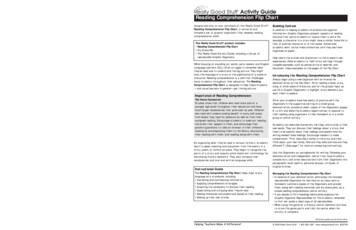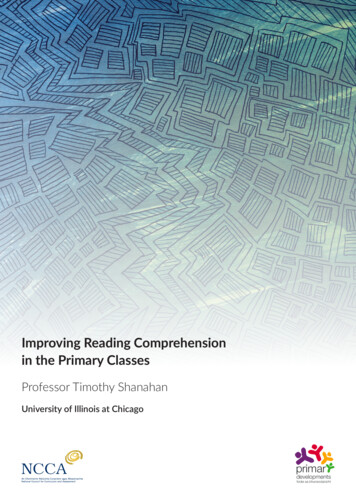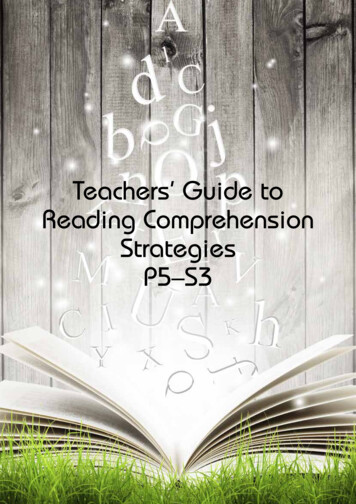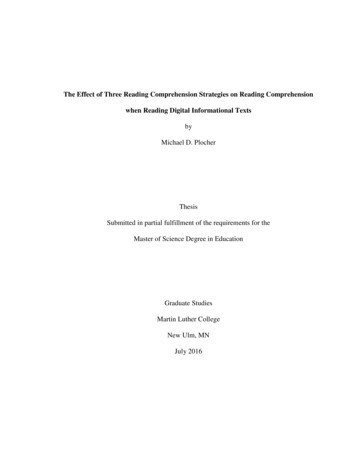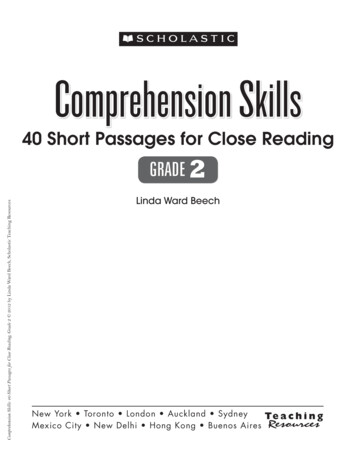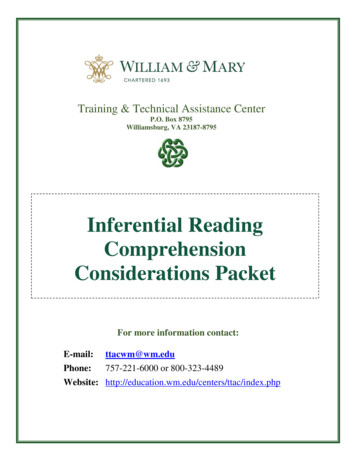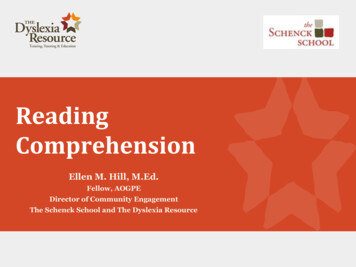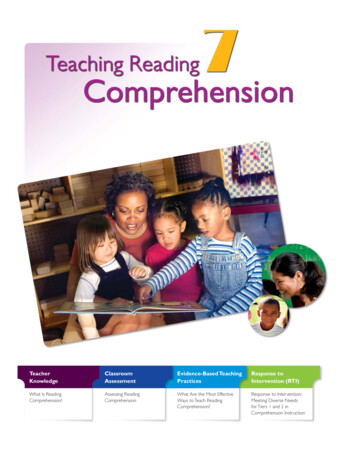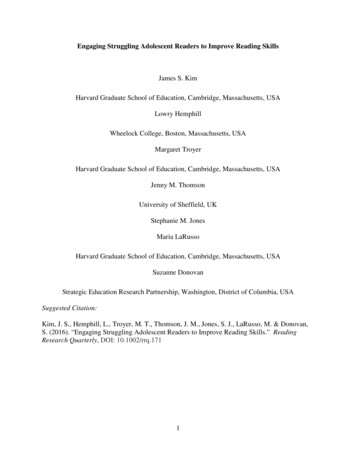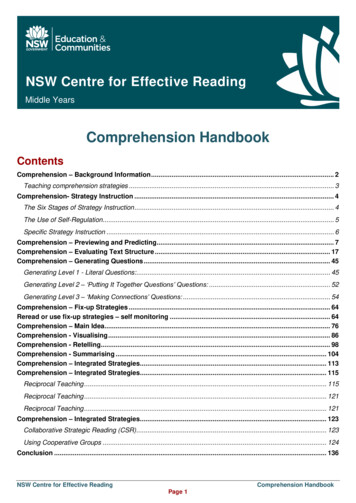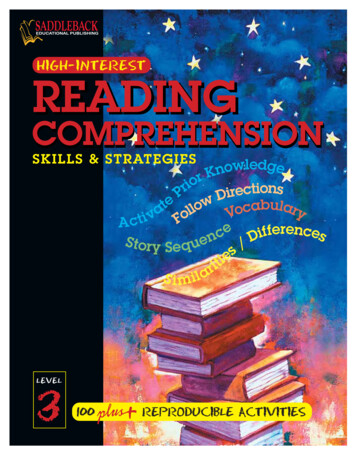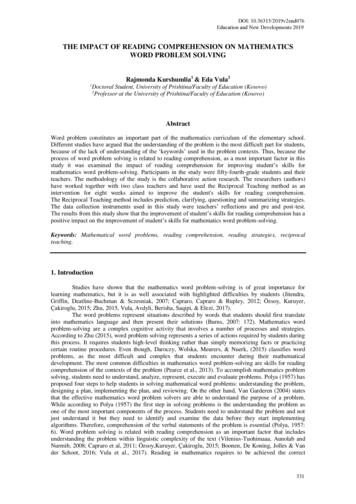
Transcription
DOI: 10.36315/2019v2end076Education and New Developments 2019THE IMPACT OF READING COMPREHENSION ON MATHEMATICSWORD PROBLEM SOLVINGRajmonda Kurshumlia1 & Eda Vula21Doctoral Student, University of Prishtina/Faculty of Education (Kosovo)2Professor at the University of Prishtina/Faculty of Education (Kosovo)AbstractWord problem constitutes an important part of the mathematics curriculum of the elementary school.Different studies have argued that the understanding of the problem is the most difficult part for students,because of the lack of understanding of the ‘keywords’ used in the problem contexts. Thus, because theprocess of word problem solving is related to reading comprehension, as a most important factor in thisstudy it was examined the impact of reading comprehension for improving student’s skills formathematics word problem-solving. Participants in the study were fifty-fourth-grade students and theirteachers. The methodology of the study is the collaborative action research. The researchers (authors)have worked together with two class teachers and have used the Reciprocal Teaching method as anintervention for eight weeks aimed to improve the student's skills for reading comprehension.The Reciprocal Teaching method includes prediction, clarifying, questioning and summarizing strategies.The data collection instruments used in this study were teachers’ reflections and pre and post-test.The results from this study show that the improvement of student’s skills for reading comprehension has apositive impact on the improvement of student’s skills for mathematics word problem-solving.Keywords: Mathematical word problems, reading comprehension, reading strategies, reciprocalteaching.1. IntroductionStudies have shown that the mathematics word problem-solving is of great importance forlearning mathematics, but it is as well associated with highlighted difficulties by students (Jitendra,Griffin, Deatline-Buchman & Sczesniak, 2007; Capraro, Capraro & Rupley, 2012; Özsoy, Kuruyer,Çakiroglu, 2015; Zhu, 2015, Vula, Avdyli, Berisha, Saqipi, & Elezi, 2017).The word problems represent situations described by words that students should first translateinto mathematics language and then present their solutions (Burns, 2007: 172). Mathematics wordproblem-solving are a complex cognitive activity that involves a number of processes and strategies.According to Zhu (2015), word problem solving represents a series of actions required by students duringthis process. It requires students high-level thinking rather than simply memorizing facts or practicingcertain routine procedures. Even though, Daroczy, Wolska, Meurers, & Nuerk, (2015) classifies wordproblems, as the most difficult and complex that students encounter during their mathematicaldevelopment. The most common difficulties in mathematics word problem-solving are skills for readingcomprehension of the contexts of the problem (Pearce et al., 2013). To accomplish mathematics problemsolving, students need to understand, analyze, represent, execute and evaluate problems. Polya (1957) hasproposed four steps to help students in solving mathematical word problems: understanding the problem,designing a plan, implementing the plan, and reviewing. On the other hand, Van Garderen (2004) statesthat the effective mathematics word problem solvers are able to understand the purpose of a problem.While according to Polya (1957) the first step in solving problems is the understanding the problem asone of the most important components of the process. Students need to understand the problem and notjust understand it but they need to identify and examine the data before they start implementingalgorithms. Therefore, comprehension of the verbal statements of the problem is essential (Polya, 1957:6). Word problem solving is related with reading comprehension as an important factor that includesunderstanding the problem within linguistic complexity of the text (Vilenius-Tuohimaaa, Aunolab andNurmib, 2008; Capraro et al, 2011; Özsoy,Kuruyer, Çakiroglu, 2015; Boonen, De Koning, Jolles & Vander Schoot, 2016; Vula et al., 2017). Reading in mathematics requires to be achieved the correct331
ISSN:2184-044X ISBN:978-989-54312-6-7 2019mathematical understanding of words for developing and understanding problem solutions. ‘Studentsneed to understand the word problem to be able to solve it, not just simply to read it, they should be goodreaders. Good readers and good math word problem solvers have the ability to observe theirunderstanding ‘(Capraro, et al., 2011). Achieving the meaning of written texts or sentences is one of themain pillars of developing the reading skills. However, the simple fact that children can read does notmean that they also can understand what they have read. Therefore, performance in word problem solvingis closely related to reading comprehension performance (Vilenius-Tuohimaa et al., 2008; Özsoy,Kuruyer, Çakiroglu, 2015). Students should develop skills of good readers and use the readingcomprehension strategies for understanding the mathematical content of word problems. Theoreticalmodels and teaching strategies for solving word problems in mathematics proposed by many researchersare based on the use of reading comprehension as a tool for enhancing the level of achievement in solvingthis type of problems (Carparo et al., 2012; Jitendra et al., 2007).Reciprocal Teaching is a method which includes reading comprehension strategies to helpstudents to improve reading comprehension. Reciprocal teaching is characterized as a dialogue throughwhich teachers and students work together to understand the text (Palinscsar & Brown, 1986). Thisapproach includes strategies: prediction, clarifying, questioning and summarizing. Each of the strategiesof the reciprocal teaching method promotes both comprehensions of text and comprehension monitoring.When students make predictions, they hypothesize what the author will discuss next in the text. To do thissuccessfully, they must activate the relevant background knowledge that they already possess. Clarifyingis particularly important with students who have comprehension difficulties of the text they read.Question generating gives the students an opportunity to identify the kind of information that provides thesubstance for a good question and summarizing is an excellent tool for integrating the informationpresented in the text (Palincsar & Brown, 1986).The purpose of the study is to examine the impact of reading comprehension on mathematicsword problem-solving. Firstly, it was important to see how reciprocal teaching can improve the readingcomprehension and secondly, how this improvement has an impact on students’ outcomes for solving themathematics word problems.2. MethodIn this study, we chose to conduct collaborative action research. This approach focuses onempowering teachers in schools, improving teaching practices and the active involvement of teachers andstudents in teaching and learning activities. Thus, as researchers (authors) and two teacherscollaboratively have planed the intervention in their classes. During the study through observation, reviewof student’s work and reflection of teachers, it is possible to explore the dynamics, challenges andpossible limitations.The data collection instruments and techniques that have been used in this research are pre- andposttest with mathematical word problems and journals with teachers’ reflections.2.1. ProcedureThe intervention method used in this study was the implementation of reading strategies ofreciprocal teaching method, based on the reciprocal teaching method created by Palincsar & Brown(1986). This method was implemented by reading comprehension strategies: predicting, clarifying,questioning and summarizing. Two teachers received the instructions from us as the researchers for theimplementation of reading comprehension strategies in their classrooms with students in small groups.The instructions for the teachers were related to the use of the reading comprehension strategies ofreciprocal teaching method: predicting, clarifying, questioning and summarizing. The reading strategieswere introduced through whole class instruction and then in smaller groups to practice the strategies. Theteachers went over the process making the strategies very clear and they worked with their students forimplementation of reading comprehension strategies.Predicting Teachers taught the students to make predictions for the text they read and to relatewith their previous knowledge, students find the information, relate to the previous knowledge andpredict what might be or what they have to do after.Clarifying Students have to clarify the unclear words, keywords, and concepts, look up for thewords and phrases that are not clear and try to clarify them.Questioning Students generate questions about the reading text, they make questions, they leadthe discussion with group members about the text they read.Summarizing Summarize meaning of the text they read, including the main idea and the mainrequest from the text (Palincsar &Brown, 1986).332
Education and New Developments 2019Teachers used those strategies with reading texts and with word problems to practice with theirstudents.Before the implementation of the intervention method, students were assessed with pretest formathematics word problem solving and again after the implementation method they are assessed withpost-test. The pretest and posttest (were the same) and they included five mathematical word problems.The reading comprehension strategies are implemented during eight weeks and the two fourthgrade teachers worked with their students in their classrooms during this time. Two teachers participatedin the research with the researcher for changing their student's attitudes toward word problem-solving inmathematics and developing their teaching practices. My role as a researcher was to guide two teachersand to collaborate with them in this collaborative action research, we gave them the guidelines for theimplementation method we work together in a whole process.Figure 1. Examples of mathematics word problems from pre-test and posttest.Në “Klubin e gjelbër” janë të regjistruar 276 fëmijë,kurse në “Klubin e artit” 105 fëmijë më pak. Sa fëmijëjanë të regjistruar në të dy klubet?In the "Green Club" are registered 276 children,whereas in the "Art Club" 105 children less. Howmany children are registered in both clubs?Andi vendosi në një album 420 fotografi që kishte bërëgjatë pushimeve. Ai vendosi 7 fotografi në një faqe tëalbumit. Sa faqe të albumit mbushi Andi?Andy put on an album 420 photos he had takenduring the holidays. He placed 7 photos on analbum page. How many pages of the album didAndi fill?In the market were sold the first week 1249 kg offruit, while the second week 80 kg more fruit. Howmany kilograms of fruit were sold over the twoweeks in the market?Në treg u shitën javën e parë 1249 kg fruta, kurse javëne dytë 80 kg më shumë fruta. Sa kg fruta u shitën gjatëdy javëve në treg?2.2. Instruments for data collectionData collection instruments were tests (pretest and posttest) and teacher’s reflective diaries.Pretest was implemented before the intervention method and posttest after the intervention method inorder to evaluate the impact of reading comprehension strategies for student's learning outcomes in wordproblem solving in mathematics, and semi-structured interviews with teachers in order to define theeffectiveness of reading comprehension for improving student’s skills for word problem solving inmathematics.2.3. SampleParticipants of the study were fifty-fourth grade students, 26 students from class IVA and 24students from class IVB (age 9-10 years old), IVA (M 9.6, SD 0.494) and IV B (M 9.5, SD 0.503)and their two classroom teachers from the “Mustafa Bakija” primary school, from Gjakova, Kosovo. Thesampling was purposeful.3. ResultsIn order to examine the impact of intervention method of reading comprehension strategies insolving mathematical word problems by students, the results from pretest and posttest were analyzedstatistically and teachers’ reflective diaries are analyzed by using the content analyses. A paired samplet-test was conducted to compare student’s scores in pretest before the intervention and after interventionon reading comprehension strategies. Results showed that students in both classes achieved better resultsin posttest comparing the pretest after intervention method for improving reading comprehension. InTable 1 are presented the basic statistics for the pretest and the post-test.Table 1. Results from pretest and posttest.PretestPosttestMeanSDMeanSDClass IV A2.381.983.883.16Class IV B3.01.814.462.14333
ISSN:2184-044X ISBN:978-989-54312-6-7 2019The t-test was utilized in order to compare the results of the pre-test and the post-test. There wasa significant difference from pretests to posttests in the scores of pretests for class IV A (M 2.38,SD 1.98 and posttest (M 3.88, SD 3.16), t (25) -4.431, p .000 in the class IVB (M 3.0, SD 1.81 andposttest M 4.46, SD 2.14), t (23) -8.085, p .000 respectively).Results have shown the significant improvement of student’s skills for mathematics wordproblem-solving in both classes IVA and IV B after the intervention program for reading comprehension.From the reflection from teacher’s diaries, it was found out that one of the main reasons whystudents struggle during mathematical word problem solving is the difficulty to comprehend the textwithin the words. The intervention for reading comprehension has a positive effect for supportingstudents to improve their word problem-solving skills.Before it was noticed that students don’t understand the text within the word problem. There weresome keywords and expressions which make students confused when they read a text or a wordproblem. Sometimes, the words are not familiar with them. But using reading comprehensionstrategies was helpful for the students to get a better meaning of the text they read as the main step tosolve the word any word problem.(Teacher A)When students read the word problem some of them get the partial meaning of what they read. It washelpful for students to use reading comprehension strategies in small groups because they felt morecomfortable when they collaborate with each other. I see that there was a significant improvement instudents’ word problem skills.(Teacher B)4. Discussion and conclusionsThis study investigated the impact of reading comprehension for improving student’s skills formathematics word problem-solving. The results from the study shown that the use of readingcomprehension strategies impact reading comprehension and have a positive effect on improvingstudent's skills for mathematical word problem-solving. The reading comprehension strategies enabledstudent's clearer meaning and comprehension of the word problems. Students after receiving theinstruction of reading comprehension strategies achieved better results in mathematical wordproblem-solving. This finding is supported by earlier studies (Vilenius-Tuohimaa et al., 2008; Özsoy,Kuruyer, Çakiroglu, 2015) which showed the relation between reading comprehension and mathematicalword problem-solving.The results from the study confirmed that students improve their comprehension when they workthrough comprehension strategies in groups, they clarified the misunderstanding content of the wordproblem and unclear expressions, they generate questions for better comprehension of the text they readand summarized their understanding. Therefore, when students improve their reading comprehension,they can perform better outcomes in mathematical word problem-solving. From this, it can be concludedthat teachers should use the reading comprehension strategies in their classes. They should work forimproving student’s reading comprehension to achieve better results in mathematical word problemsolving, and they can do this in cooperation with each other. Finally, different students have differentneeds, thus it is suggested that other approaches to word problem solving should take into consideration.ReferencesBoonen, A. J. H., De Koning, B., B., Jolles, J., Van der Schoot, M. (2016). Word Problem Solving inContemporary Math Education: A Plea for Reading Comprehension Skills Training. Frontiers inPsychology. Volume 7:191.Burns, M. (2007). About Teaching Mathematics. Sausalito, CA. Math Solution Publications.Capraro, M. R., Capraro, M.M., & Rupley, H.W. (2012). Reading-enhanced word problem solving:a theoretical model. European Journal of Psychology of Education 27, 91-114Creswell, J. W. (2012). Educational Research Planning, Conducting and Evaluating Quantitative andQualitative Research. (4th ed.) Boston. Pearson Education, IncDaroczy, G., Wolska, M., Meurers, D. W., & Nuerk, H. (2015). Word problems: a review of linguisticand numerical factors contributing to their difficulty. Frontiers in Psychology. Volume 6:348.James, E.A., Milenkiewicz, M.T., Bucknam, A. (2008). Participatory Action Research for EducationalLeadership:Using Data-Driven Decision Making to Improve Schools. California. SagePublications.334
Education and New Developments 2019Jitendra, A. K., Griffin, C. C., Deatline-Buchman, A., & Sczesniak, E. (2007). Mathematical wordproblem-solving in third-grade classrooms. Journal of Educational Research, 100, 283–302.Özsoy, G. & Kuruyer H. G. & Çakiroğlu, A. (2015). Evaluation of Students' MathematicalProblem-Solving Skills in Relation to Their Reading Levels. International Electronic Journal ofElementary Education, 8(1), 113-132. Polya, G. (1957). How to Solve It. New Jersey. PrincetonUniversity Press.Palincsar, A.S. & Brown, A. L. (1986). Interactive Teaching to Promote Independent Learning from Text.The Reading Teacher. Vol.39, No.8, pp. 771-777Pearce, D. L., Bruun, F., Skinner, K., Lopez-Mohler, C. (2013). What teachers say about studentdifficulties solving mathematical word problems in grades 2-5International Electronic Journal ofMathematics Education, Vol.8, No.1Vilnius-Tuohimaa, M. P., Aunola, K., & Nurmi, J. E. (2008). The Association Between MathematicalWord Problems and Reading Comprehension. Educational Psychology, 28(4), 409-426.Vula, E., Avdyli, Rr., Berisha, V., Saqipi, B., Elezi, Sh., (2017). The impact of metacognitive strategiesand self-regulating processes of solving math word problems. International Electronic Journal ofElementary Education, 10(1), 49-59.Zhu, N. (2015). Cognitive Strategy Instruction for Mathematical Word Problem-solving of Students withMathematics Disabilities in China. International Journal of Disability, Development, andEducation, 2015 Vol. 62, No. 6, 608–627.335
The results from this study show that the improvement of student’s skills for reading comprehension has a positive impact on the improvement of student’s skills for mathematics word problem-solving. Keywords: Mathematical word problems, reading comprehension, reading
